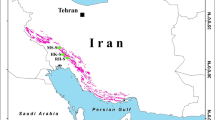Abstract
Karstic rocks exist in different areas of the world having by case useful/harmful structural and environmental impacts. These rocks like gypsum and salt are dissolved against water.
In the current research, gypsum solubility is investigated by collecting outcomes of several experiments on crushed gypsums. During the tests, rates of gypsum solubility were measured and appraised through application of various parameters such as compaction quantity, period of water flow inside specimen as well as diameter of the initial trial hole increase.
The initial trial holes’ diameters were 0 (in the specimen without hole), 5, 8, 10 and 12 millimeters. Two compaction cases were comprised; with and without compaction. Furthermore it should be mentioned that flow of water was continued inside the specimens for a period of 3, 10, 20 and 30 days in the separate experiments in order to assess the time factor on the solubility quantity of the gypsum. Solution rate respectively for crushed gypsum were computed 2.49 cm/year. These experiments indicate that progress of solution phenomena does not have a particular trend.
Similar content being viewed by others
References
Douchko Romano, Franci Gabrovsje, Wolfgang Dreybrodt (2003) Dam sites in soluble rocks: a model of increasing leakage by dissolutional widening of fractures beneath a dam. Engg. Geol. Jour. (Elsevier), pp.17–35.
Dreybrodt, W. and Eisenlohr, L. (2000) Limestone dissolution rates in karst environments. In: A. Klimchouk, D.C. Ford, A.N. Palmer and W. Dreybrodt (Eds.), Speleogenesis: Evolution of Karst Aquifers. Natl. Speleol. Soc., USA, pp.136–148.
Foster, S.S.D. and Perry, C.J. (2010) Improving groundwater resource accounting in irrigated areas: a prerequisite for promoting sustainable use. Hydrogeology Jour., v.18, pp.291–294.
Jeschke, A.A., Vosbeck, K. and Dreybrodt, W. (2001) Surface controlled dissolution rates in aqueous solutions exhibit nonlinear dissolution kinetics. Geochim. Cosmochim. Acta, v.65, pp.13–20.
Johnson K.S. (2003) Gypsum karst and abandonment of the Upper Mangum Damsite in Southwestern Oklahoma. Evaporite Karst and Engineering/environmental problems in the United States. Oklahoma Geol. Surv. Circular 109, pp.85–94
Johnson, K.S. (2003) Evaporite-Karst problems in the United States”Evaporite Karst and Engineering/environmental problems in the United States: Oklahoma Geol. Surv. Circular 109, pp.1–20.
Johnson, K.S. (2003) Gypsum Karst as a major factor in the design of the proposed Lower Mangum Dam in southwestern Oklahoma” Evaporite Karst and Engineering/environmental problems in the United States: Oklahoma Geol. Surv. Circular 109, pp.95–111.
Milanovic P.T. (2000) Geological Engineering in Karst. Zebra Publ..
Author information
Authors and Affiliations
Corresponding author
Rights and permissions
About this article
Cite this article
Behnamtalab, E. Experimental evaluation of solubility of gypsum. J Geol Soc India 80, 262–266 (2012). https://doi.org/10.1007/s12594-012-0136-6
Received:
Accepted:
Published:
Issue Date:
DOI: https://doi.org/10.1007/s12594-012-0136-6




